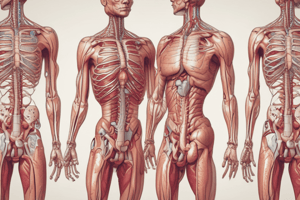Podcast
Questions and Answers
The cardiovascular system is also known as the ______ system.
The cardiovascular system is also known as the ______ system.
circulatory
The ______ receives blood, and the ventricles pump blood out of the heart.
The ______ receives blood, and the ventricles pump blood out of the heart.
atria
Arteries carry ______ blood away from the heart.
Arteries carry ______ blood away from the heart.
oxygenated
Red blood cells carry ______ in the blood.
Red blood cells carry ______ in the blood.
The pulmonary circulation involves the heart, ______, and the heart again.
The pulmonary circulation involves the heart, ______, and the heart again.
Blood pressure is regulated by ______ rate.
Blood pressure is regulated by ______ rate.
The autonomic nervous system has two branches: the ______ nervous system and the parasympathetic nervous system.
The autonomic nervous system has two branches: the ______ nervous system and the parasympathetic nervous system.
The ______ nervous system decreases heart rate and blood pressure.
The ______ nervous system decreases heart rate and blood pressure.
Platelets are involved in ______ clotting.
Platelets are involved in ______ clotting.
The cardiovascular system transports ______ and nutrients to cells and tissues.
The cardiovascular system transports ______ and nutrients to cells and tissues.
Flashcards are hidden until you start studying
Study Notes
Overview
The cardiovascular system, also known as the circulatory system, is a network of organs and vessels that transport blood throughout the body.
Functions
- Transports oxygen and nutrients to cells and tissues
- Removes waste products, such as carbon dioxide and lactic acid
- Regulates body temperature
- Maintains pH balance
- Supports immune function
Components
Heart
- Muscular organ that pumps blood throughout the body
- Divided into four chambers: left and right atria, and left and right ventricles
- Atria receive blood, ventricles pump blood out of the heart
Blood Vessels
- Arteries: carry oxygenated blood away from the heart
- Veins: carry deoxygenated blood back to the heart
- Capillaries: allow for exchange of oxygen and nutrients with cells
Blood
- Liquid connective tissue composed of:
- Plasma (water, proteins, nutrients, waste products)
- Red blood cells (carry oxygen)
- White blood cells (part of immune system)
- Platelets (involved in blood clotting)
Blood Circulation
- Pulmonary circulation: heart → lungs → heart (oxygenation of blood)
- Systemic circulation: heart → body tissues → heart (delivery of oxygen and nutrients)
Blood Pressure
- Force exerted by blood on vessel walls
- Regulated by:
- Heart rate
- Blood volume
- Vessel diameter
Regulation of the Cardiovascular System
- Autonomic nervous system (ANS) regulates heart rate and blood pressure
- ANS has two branches:
- Sympathetic nervous system (increases heart rate and blood pressure)
- Parasympathetic nervous system (decreases heart rate and blood pressure)
Overview
- The cardiovascular system is a network of organs and vessels that transport blood throughout the body.
Functions
- The cardiovascular system transports oxygen and nutrients to cells and tissues.
- It removes waste products such as carbon dioxide and lactic acid.
- It regulates body temperature.
- It maintains pH balance.
- It supports immune function.
Components
Heart
- The heart is a muscular organ that pumps blood throughout the body.
- It has four chambers: left and right atria, and left and right ventricles.
- The atria receive blood, while the ventricles pump blood out of the heart.
Blood Vessels
- Arteries carry oxygenated blood away from the heart.
- Veins carry deoxygenated blood back to the heart.
- Capillaries allow for the exchange of oxygen and nutrients with cells.
Blood
- Blood is a liquid connective tissue composed of plasma, red blood cells, white blood cells, and platelets.
- Plasma consists of water, proteins, nutrients, and waste products.
- Red blood cells carry oxygen.
- White blood cells are part of the immune system.
- Platelets are involved in blood clotting.
Blood Circulation
- Pulmonary circulation involves the heart, lungs, and heart again, and it is the pathway for oxygenation of blood.
- Systemic circulation involves the heart, body tissues, and heart again, and it is the pathway for the delivery of oxygen and nutrients.
Blood Pressure
- Blood pressure is the force exerted by blood on vessel walls.
- It is regulated by heart rate, blood volume, and vessel diameter.
Regulation of the Cardiovascular System
- The autonomic nervous system (ANS) regulates heart rate and blood pressure.
- The ANS has two branches: the sympathetic nervous system and the parasympathetic nervous system.
- The sympathetic nervous system increases heart rate and blood pressure.
- The parasympathetic nervous system decreases heart rate and blood pressure.
Studying That Suits You
Use AI to generate personalized quizzes and flashcards to suit your learning preferences.




